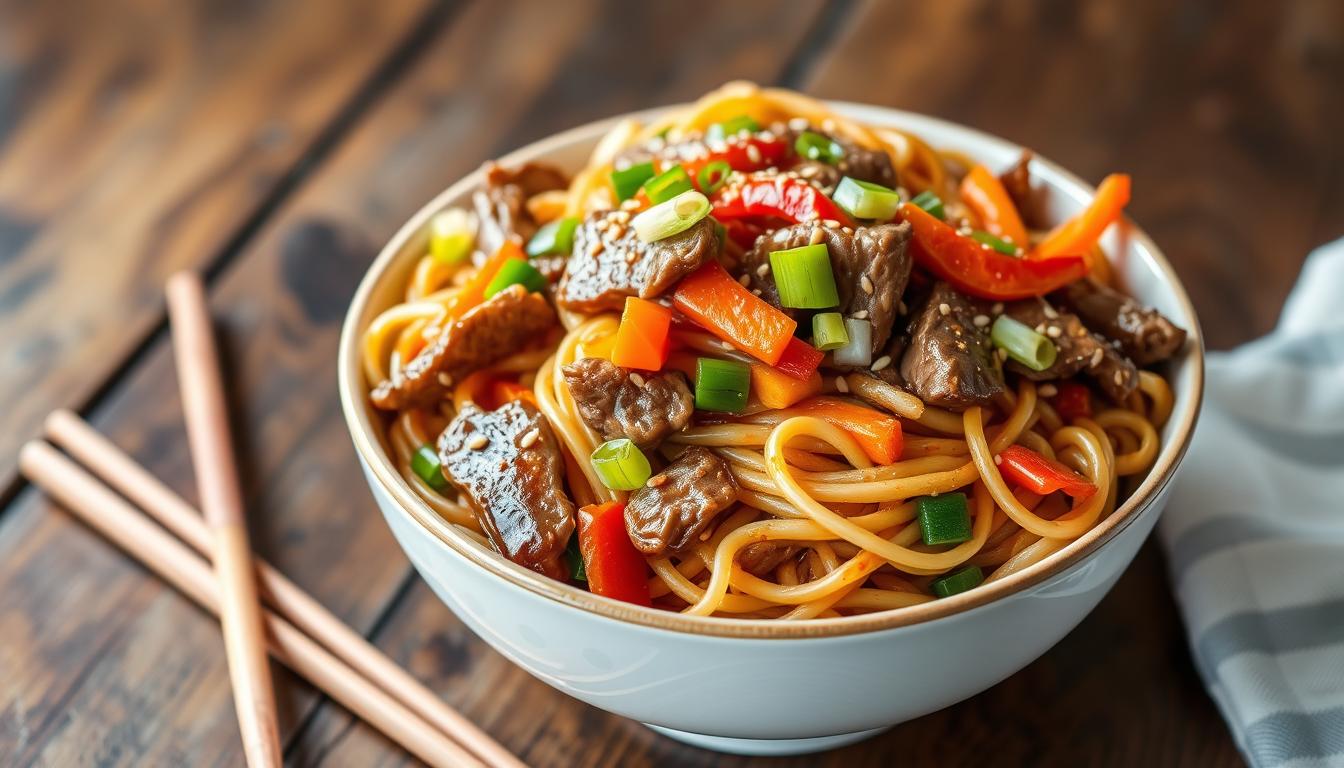Beef lo mein is a beloved Chinese stir-fry dish that has captured the hearts of food enthusiasts worldwide. Originating from the vibrant culinary traditions of China, this flavorful meal features tender beef strips, chewy noodles, and a medley of crisp vegetables, all tossed in a savory sauce. The beauty of this homemade beef lo mein recipe lies in its simplicity and the ease of preparation, making it an ideal weeknight dinner option for busy households. With its perfect balance of textures and flavors, this easy beef lo mein recipe is sure to satisfy your cravings for authentic Chinese stir-fry noodles.
Essential Ingredients for Perfect Beef Lo Mein
Crafting an authentic and flavorful beef lo mein dish begins with selecting the right ingredients. From the foundation of lo mein noodles to the succulent flank steak or sirloin, each component plays a crucial role in achieving that signature taste and texture.
Selecting the Right Noodles
The noodles are the backbone of lo mein, and the choice can make all the difference. Fresh lo mein noodles are the traditional pick, offering a tender yet slightly chewy bite. Dried lo mein noodles also work well, providing a similar texture and absorbing the savory flavors of the dish.
Best Cuts of Beef for Lo Mein
When it comes to the beef, flank steak and sirloin are excellent choices. These cuts are naturally tender and flavorful, making them well-suited for the quick-cooking lo mein preparation. Be sure to thinly slice the beef against the grain to ensure a delightfully tender and juicy result.
Sauce Components and Aromatics
The lo mein sauce is the heart of the dish, and it’s made up of a harmonious blend of oyster sauce, soy sauce, and sesame oil. These umami-rich ingredients, combined with aromatic vegetables like garlic, ginger, and scallions, create the signature lo mein flavor profile that keeps us coming back for more.
Beef Lo Mein Recipe: Step-by-Step Instructions
Elevate your home-cooked meals with this easy-to-follow beef lo mein recipe. Discover the secrets to achieving restaurant-quality results by mastering the art of stir-frying and marinating the beef to perfection.
To begin, take your time to properly marinate the beef. Slice the flank steak against the grain into thin strips, then combine them with soy sauce, rice vinegar, sesame oil, and a touch of cornstarch. Let the beef soak up these flavors for at least 30 minutes, or up to 2 hours in the refrigerator.
While the beef is marinating, prepare the remaining ingredients. Cook the lo mein noodles according to package instructions, then drain and set aside. Slice the bell peppers, onions, and any other desired vegetables into bite-sized pieces.
- Heat a large wok or skillet over high heat. Add a drizzle of oil and the marinated beef. Stir-fry the beef until it’s slightly charred and cooked through, about 3-5 minutes. Remove the beef from the wok and set aside.
- In the same wok, add a bit more oil if needed. Stir-fry the sliced vegetables for 2-3 minutes, until they’re tender-crisp.
- Add the cooked noodles, the reserved beef, and the sauce (a mixture of soy sauce, oyster sauce, and sesame oil) to the wok. Toss everything together, allowing the flavors to meld and the noodles to heat through, about 2-3 minutes.
- Finish with a sprinkle of green onions and a drizzle of sesame oil, if desired. Serve hot and enjoy your homemade beef lo mein!
By following these step-by-step instructions and mastering the technique of high-heat stir-frying, you’ll be able to recreate the delicious flavors of your favorite takeout dish right in your own kitchen. Bon appétit!
Tips for Restaurant-Style Lo Mein Results
Achieving the coveted “wok hei” or “breath of the wok” is the key to unlocking restaurant-quality beef lo mein at home. The secret lies in maintaining a scorching-hot wok and tossing the ingredients with a deft hand. By searing the beef and noodles in small batches, you can create that signature smoky, caramelized flavor that sets authentic lo mein apart.
Balanced seasoning is also crucial for a truly satisfying dish. Pay close attention to the sauce components, adjusting the ratio of soy sauce, rice vinegar, and sesame oil to your personal taste. A sprinkle of white pepper and a dash of Worcestershire sauce can also enhance the umami notes. Don’t be afraid to experiment with different protein options or add extra vegetables to customize the recipe to your liking.
Finally, proper noodle preparation is paramount. Opt for fresh lo mein noodles if possible, and be sure to thoroughly drain and toss them with a small amount of oil before adding to the wok. This helps prevent the noodles from sticking together and ensures each bite is perfectly cooked and textured. Pair your homemade beef lo mein with steamed rice, a crisp side salad, and a refreshing beverage for a complete restaurant-inspired meal.

